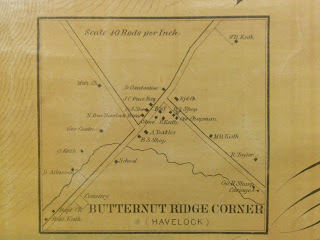Without my walking stick, I'd go
insane
Can't look my best, I'd feel
undressed without my cane
- My Walking
Stick by Irving Berlin
Unlike Irving Berlin, today’s modern man would likely never fear for
his sanity if he went out without his walking stick. But if this dandy was the
walking stick in question, well maybe he would feel a bit bereft.
Today’s hidden history object is one of MANY canes in our collection.
Irving Berlin was not kidding about their popularity; the quantity that have
made their way to the museum suggest that every fancy man in Kings County
carried one when he went out sporting (plus had two or three in the umbrella stand
at home waiting in reserve).
The sticks in our collection vary widely; some were purely functional,
others ‘commemorative’ gifts to mark a significant anniversary or milestone,
while others like this whale bone model fall into the, “well…. that’s
interesting?!” category.
This walking stick was brought to Saint John in the 1880s by a sea captain
by the name of Jones. The stick is made of stacked whale vertebrae – 97 pieces
in total- that are mounted over an iron rod. The iron sticks out at the bottom
to provide a sharp tip for the cane. The head of the cane is made of ivory and joins the main body of the cane by a series of exotic hardwood bands. This is one of two walking sticks owned by
Captain Jones – the other is from the West Indies and has a large carved snake
that curls down the shaft of the stick.

A seasoned rabologist (that’s the scientific name for a collector of
walking sticks; and, yes, there is such an affliction) will tell you that walking
sticks are the civilized evolution of sword
carrying in the post-knight era. In fact, some walking sticks are known as
‘sword sticks’ because they hide a tiny sword or blade within the stick. We
would argue, however, that the walking stick has a less elevated history, that
they are simply the evolution of the stick (i.e. caveman club, Irish shillelagh,
etc.).
The walking stick makes a handy support when walking (obviously), a
great parter-of-bushes, tester-of-puddles and, in desperate situations,
something to hurl willy-nilly if you are confronted by a wild animal. They are
also a fine accessory for an evening on the town – especially if you've decided
to wear your high hat, white spats and tails.
Take away my high hats
Take away my favorite tie
Take away my white spats
I'll still get by
But my walking stick
You simply must let that be
I mean you can't take that away
from me
[Refrain:]
Without my walking stick, I'd go
insane
Can't look my best, I'd feel
undressed without my cane
Must have my walking stick 'cause
it may rain
And when it pours, can't be
outdoors without my cane
If I ever left my house without
my walking stick
It would just be something I
could never explain
The thing that makes me click on
Lovers' Lane
Would go for naught if I were
caught without my cane
If you are loving the lyrics, have a listen to a 1938 recording of the Irving Berlin classic by Louis Armstrong and the Mills Brothers here!































